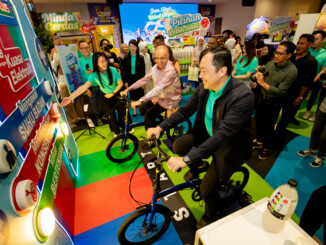Where the heck does ‘Lat Talilat’ come from?!
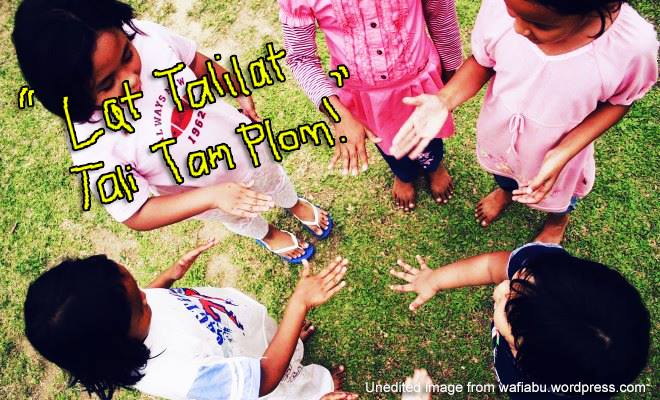
- 3.6KShares
- Facebook3.5K
- Twitter7
- LinkedIn3
- Email13
- WhatsApp42
Lat Tali Lat Tali Tam Plom,
Mak Minah balik kampong,
Beranak dalam tong,
Keluar anak patong,
Dipotong menjadi sotong.
Admit it ugaizzz, to those that are familiar with the rhyme, you are singing along with it kan, right up till “dipotong menjadi sotong” right? When we were kids, we played other old-school Malaysian games such as batu seremban, ketingting (that’s hopscotch for you angmohs), and Pepsi-Cola, but nothing is as uniquely Malaysian as Lat Talilat Tali Tam Plom.
To refresh your memory, this is usually played by three players or more to decide how to split into two teams. Everyone gathers in a circle, puts one hand in and go “lat talilat tali tam plom!” with hand-fanning motions. (Click here to see how it’s played)
It wouldn’t be surprising for most of y’all if we still use Lat Talilat as adults today for non-games purposes, like deciding who to drive out for lunch.
But did you know there are OTHER VERSIONS?!
[interaction id=”565bcf0db8db3ddc5e98b105″]
Hailing from the land of limestone hills and beansprouts chicken (Ipoh la), the writer has not heard of the phrase “Lat Talilat”. There, many say it as “Lai Lai Li Li Lat Tam Pom”. In fact, hearing the phrase “Lat Talilat” is something that is still quite foreign to process.
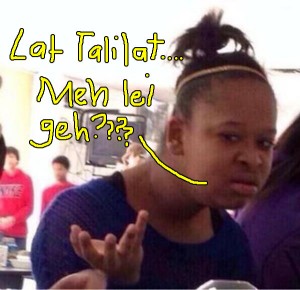
So we kinda had a theory in mind lah. As with food, and slang words in Malaysia, maybe Lat Talilat is affected by where you come from (and spend your childhood years). How do we find out more about the different versions and the story behind it? Kacau our friends and family lor.
We want to stress that this list is NOT EXHAUSTIVE – these are the people we manage to kacau, so be kind lah hah 🙂
| THIS IS HOW WE DO IT |
LOCATION | GENERATION |
| La la li la tam pong | Kangar, Perlis | 1990’s |
| La la li la tam pong | Butterworth, Penang | 1980’s |
| Lai lai li li lat tam pom | Ipoh, Perak | 1990’s |
| Lat talilat tali tam plom | Kuala Lumpur | 1970’s |
| Lat talilat tali tam plom | Petaling Jaya, Selangor | 1980’s |
| Lat talilat tam pom | Seremban, Negeri Sembilan | 1940’s |
| Lat talilat tam pong | Segamat, Johor | 1990’s |
| Lat talilat tali tam plong | Johor Bahru, Johor | 1950’s |
| Lat talilat tali tam pom | Kuala Lumpur | 1990’s |
Walauuu got so many different versions! But if you study it closely, they are pretty similar – Klang Valley to Johor use Lat Talilat variations whereas Northern flers use the La’s and Lai’s. To make things a lil exciting, we asked a Malaysian from across the sea.
“If we want to know who goes to what group and we want it to be fair, we just bergesture. When you show your friends the gesture of palms up and down, we know already. It’s 1, 2, 3, palms up or down.” – Tryphena Chin, 22, from Kota Kinabalu, Sabah.
We spoke to an Iban from Miri, Sarawak who chose to be anonymous and he told CILISOS that there’s no song and rhyme too when they play. Err…
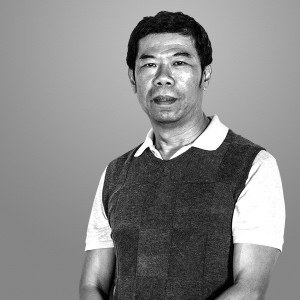
To make it seem more legit (CILISOS does our homework! *wink wink*), we spoke to Chang Kim Hua, founder of GohKaki’s Childhood Museum and advocate of traditional childhood games.
In an interview with CILISOS, Chang told us that it is read differently because every state or culture have their own “singing version”. While there are other variations, most of them reflect the kampung lifestyle of the old days.
Lat Tali Lat Tam Pong
Balik Kampong
Makan Kangkong
Masak Ikan Kembong
Beranak Dalam Tong
Keluar Anak Patong.
BUT… what if we tell you that there are other languages of the song?? Event planner and traditional games enthusiast Catherine Chang told us there are Cantonese and Hokkien versions of Lat Talilat too!
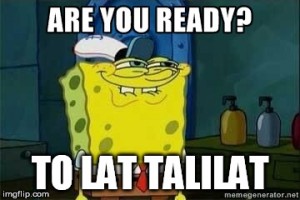
CANTONESE
La la li li la tam pong
Sek fan em sai soong (have rice without any dishes)
Ah ma ta ngor ta em tung (when my mom beats me, it’s not too painful)
Ah pa ta ngor see futt tung (when my dad beats me, backside hurts)
La la li la tam pong
Ah Pek bay apom (Old man/uncle sells pancake)
Apom tim lok hai (Pancake is thrown into the sea)
Ah Pek jiak kau sai (Old man/uncle eats dog poo)
Apparently there’s a Hakka version too (CILISOS team has no Hakka connections, the closest thing would be the writer’s love for Hakka lei cha rice), but our sources can’t seem to confirm the full song so we didn’t put one here. But if any of u Hakka-speaking gaizz remember this version, let us know okay? 🙂
How long have we been Lat Talilat-ing and who started it??
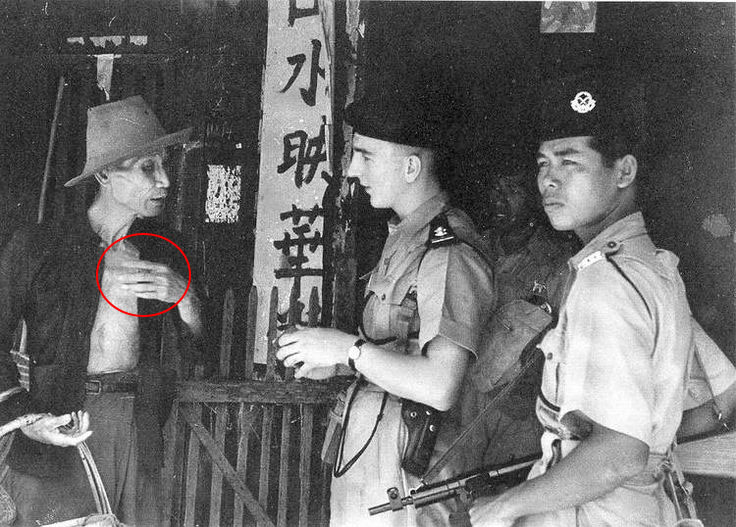
In our journey to find some answers, we spoke to ugaizz, from college-going young adults in their 20s to an elderly couple in their late 60s.
“We have been searching for the origins and found that people were playing Lat Talilat in their childhood since before 1957.” – he said.
This would make sense because when we were speaking to most of our parents, they did play Lat Talilat when they were young. We even spoke to an elderly couple in their late 60’s that were kids during pre-Merdeka days! Like most cultural identities, different states or groups have different interpretations but we can say that Malaysians have been Lat Talilat-ing our hands in a satay-fanning motion for at least 60 years now!
It is debatable who started it or where it first came about but our editor had a whale of an idea.

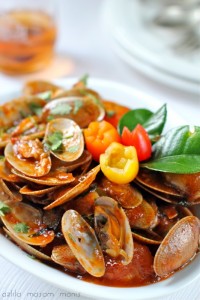
We did some googling and found this Thai style lala (clams) dish called Lala Tam Plom, which is a Thai-style Lala dish. There’s Lala Tam Plom… and La La Li La Tam Pong. Come to think of it, the phrase does sound a bit Thai lah to our Malaysian ears, so we got our expert to connect some geography dots..
“We suspect that Lat Talilat is mostly from Kelantan, but it’s not confirmed so we are still looking at the origins.” – Chang said.
So Kelantan shares a border with the southern part of Thailand right, and in fact there’s a significant population of Thais in the state, which would make sense if Lat Talilat has a Siamese influence kan?
Here’s where we could be mistaken. As we were poking around on social media, Bangkok-based fixer Ryn Jirenuwat, 29, tells us that the phrase “Lat Talilat Tam Pong” is not even remotely Thai! But hang on, cause we found out that they have their OWN version of Lat Talilat which means…
Lat Talilat is international?!?!
Well as far as we know, Thailand and South Korea has it! #guiltyforclickbaityheader..
“In Thailand, most kids here play O-Wa Noi Ook, with usually 3 kids playing this game. And they will chant “O-Wa Noi Ook” while shaking hands and when the chant ends with “Ook”, everybody needs to flip – palm up or down.” – Ryn said in an interview with CILISOS.
The rules for O-Wa Noi Ook (translates to odd hands out) is similar to Lat Talilat, where they play it to select or eliminate players for a team. And just like what we have in Malaysia, the name of the game differs from region to region. They say O-Wa Noi Ook in central Thailand, whereas those in northern Thailand use “O-Wa-Pae”.
Even if we speak different languages but we share a common ground in being as clueless with the history of where Lat Talilat/O-Wa Noi Ook came from. 😳
One of the recurring themes is that the “song” is sung differently according to regions. But here’s where the South Korean’s Lat Talilat called 데댄찌, or De Den Jji is a bit different from ours. If you check this video out (our Korean source tells us this is a Seoul “thing”), at the end of their Lat Talilat-ing, some will raise their arms with palms up/palms down, and some will lower theirs.
We didn’t get the chance to get legit sources from other countries, Asian and elsewhere. But we’re pretty sure a kid across the globe now is playing his localised version of Lat Talilat now. Just like how we Malaysians play One, Two, Som, or as the angmohs call it – Rock, Paper, Scissors.
So does this mean we are all same same?
Chang emphasised that the history on local rhymes are different and every state will share a different story. Along the way, this iconic game is just like most Malaysian dishes, everything has been rojakfied and we get the result of this Lat Talilat in different singing versions.
We would want to emphasise that there’s no conclusive proof for the origins of Lat Talilat. Heck, even if the guys at UNESCO Bangkok can’t find the history for the Thai’s O-Wa Noi Ook, so we tried and did our best lah.
The Star wrote an article “Top 10 Games People Used To Play“ and Lat Talilat is one of them. So instead of leaving traditional games like these in the past, the young and old can still participate in their nostalgia trip in cultural and heritage events like the ones organised by Goh Kaki Childhood Museum and One Tree Foundation, an initiative by enthusiasts like Catherine.
Perhaps it’s not so much of where it came from, but the memories we have of it and the meaning it carries. So maybe it’s not just a childhood game, but a big part of our Malaysian culture that will always have a soft spot in everyone of us.
But if you’re not feeling so nostalgic now, then check out this entertaining live performance of the Hokkien Lat Talilat. Enjoy! 😀
- 3.6KShares
- Facebook3.5K
- Twitter7
- LinkedIn3
- Email13
- WhatsApp42





